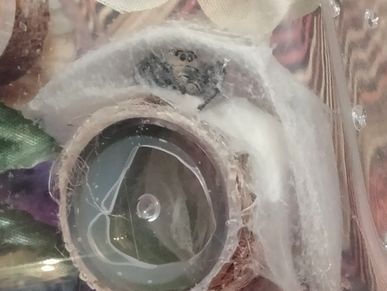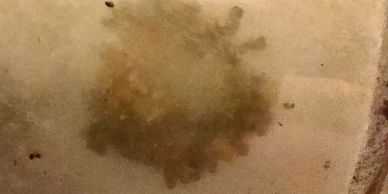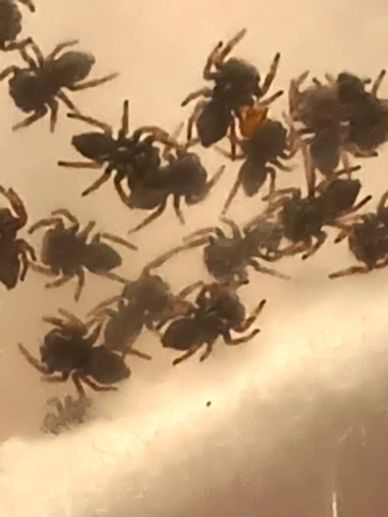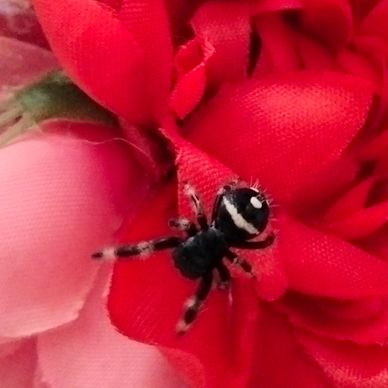Jumping Spider Life Cycle: Molting & Instars
The First Stage Of Life

Mama will begin to build a large nest and eventually lay her eggs. The nest will be large & grand, bigger than any hammock before. She will guard over her nest for a week or two before venturing out for food. In this stage, the egg sack needs moisture and sunlight and mama needs rest.
First Instar

Eventually the egg sac will turn from a pale yellow to black. This means the spiderlings have had their first molt, or are in their first instar! They will slowly break out of the sac and begin exploring Mama's beautiful nest she built. At this stage the spiderlings just need moisture and care of their Mama. As adorable as it sounds, the mama's will scoop the young back into the nest if the little ones try to leave too soon.
Second Instar

The baby jumpers will roam around the nest, eventually molting again into their second instar! At this stage they will have larger heads than their bodies and will begin to completely leave the nest in search of food.
If you are caring for a nest of spiderlings, it's time to begin feeding them small fruit flies every other day. They'll need 3-5 fruit flies each, so with 150 spiderlings...do the math, that's like a zillion fruit flies! So best to be prepared and have tons on hand ahead of time.
It's best that the spiderlings be kept together for as long as possible. They will group hunt, meaning the smaller ones can tag along on the catch of big brother. They will also begin to build their own hammocks that they'll need for their next successful molts.
It's around this time that Mama will begin planning to lay another egg sac. In the wild this will all happen naturally and the second instar babies will venture off on their own.
In captivity, the Mama will be moved to a new home in anticipation of laying another sac. The spiderlings will need high humidity & plenty of food to continue molting & growing successfully.
Third Instar = BIG CHANGES :)
Third Instar = BIG CHANGES :)

The third instar has to be the most adorable change the jumpers make! Third instar means the jumpers have molted 3 times and they now have visible markings on them. They are still to young to be able to tell the gender, and are still far too young to leave the communal nest if captive bred.
They'll need plenty of light, humidity & food to grow. Jumping spiders will repeat the pattern of fattening up and retreating to their hammocks to hibernate and shed their old skin. As they repeat this pattern, it gradually begins to slow down as they mature.
Fourth Instar
Third Instar = BIG CHANGES :)
Fourth Instar

Fourth instar is a big molt as it can be the toughest molt for jumpers to make, especially without proper humidity & food. At this stage the jumpers body elongates and continues to plump preparing for the fifth molt.
Using a special setting or lense, you can zoom in and see their adorable fuzziness begin to grow in. If you are raising captive bred spiderlings, now is a good time to watch for the aggressive babies and to begin slowly separating them into their own enclosures.
Fifth Instar
Third Instar = BIG CHANGES :)
Fourth Instar

This is one of the most exciting molts! Jumping spider features are extremely visible and if you are adopting a spider pup, they are finally old enough to be able to identify gender!
Fifth instar spiderlings should be finally living in their own homes, whether they're in the wild or captive bred. During this stage they should completely make the switch from fruit flies to larger prey if captive bred.
Juveniles

Juveniles are extremely active and enjoy hunting active prey. Juvies are 6th - 8th instar, or they have experienced 6 to 8 molts.
Because they are eating larger prey, they can go longer between feeding. Keeping an eye on the size of their abdomen is a good way of knowing when to feed next. A plump abdomen is full, as it gets thinner, the spood becomes hungrier. Spiders can overeat, so make sure to follow this important tip.
Juvies need lots of places to explore and jump. Now is a great time to relocate your jumper to a larger enclosure.
Sub Adulthood

Jumpers reach sub adulthood at 9 molts. I have seen regals and bolds molt more than 10 times, so I would say it's safe to say sub adulthood lasts until the jumper has reached maturity.
Sub adults are ready for their largest enclosures you had planned for them and love to hunt their prey, unless you've spoiled them and they have become uses to being hand fed ( this can happen with captive bred jumpers).
Nonetheless, they love to explore at this age and build hammocks in different places. You'll begin to notice each hammock serves a purpose. All the more reason to love these little guys, they're just so smart!
If you haven't began to interact with your spood and you were wanting to, now is the best time. They are very curious, but not as jumpy. And if you've had them since they were juvies or younger, you've grown on them and they are used to you by now.
Active jumpers love different prey. Mealworms, flies, dubia roaches, wax worms, etc. Be sure to have a variety on hand to keep them healthy and engaged.
Maturity
Senior Care

Jumping spiders are mature when they've molted and their sex organs are fully pronounced. Females will have a visible epigynum, a belly button of sorts, on their abdomen. Makes pedipalps will be fully developed and resemble a boxing glove. They will no molt any more once they become mature.
As jumpers mature, their metabolisms slow down. They will begin to eat once a week, and sometimes less. Males tend to eat less frequently than females at this stage of life.
Mature adults will need the same diets they've had since being sub adults, just less of it. They will still explore, drink the mist on the side of their enclosures, but you'll notice them hanging out in their hammocks more and venturing out less.
This doesn't mean they are slowing down, this just means they're enjoying the good life. Make sure they get sun and water and they'll be happy campers. I'm sure if they loved to come out and play as sub adults, they'll still enjoy some playtime as adults.
Jumpers usually reach maturity at 13-16 months old. This means they could live another 1-2 years as plump and happy adults with the right care!
Senior Care
Senior Care
Senior Care

As adults becomes seniors you'll notice some changes in their movements and they'll need some TLC.
You may notice your spood is having a hard time sticking to the side of their enclosures or not willing to eat. They may also be having trouble producing silk. This is when it is time for them to retire and you to offer up some extra special care.
You'll want to relocate them to a smaller enclosure. I use my juvie enclosures as senior enclosures, too. There is usually a hammock already made from a previous tenant and plenty of silk on the walls.
If they are still having trouble getting around you can add some mesh to the walls for easy climbing.
If your spood is refusing to hunt you can tong feed prey or offer some watermelon or sugar/honey water. Keep the day to day care the same: warmth, light and water. And keep offering food every few days.
Seeing your senior spood struggle may be tough, but just remember you're giving them all the love you can to make them comfortable and happy!
